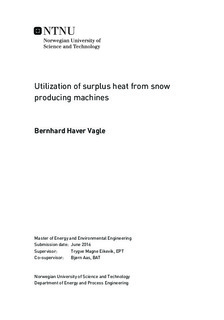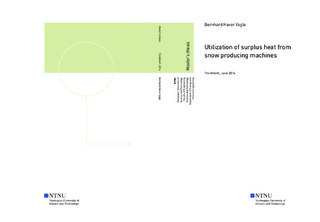| dc.description.abstract | In this master thesis, four cases of snow supply have been evaluated under the condition that a 5 km track of ski conditions can be guaranteed from November to the end of April at a nordic ski arena in Granåsen, outside of Trondheim, Norway. The four cases are:
Case A: snow storage
Case B: temperature independent snowmaking with direct heat recovery
Case C: indoor snowmaking with direct heat recovery
Case D: temperature independent snowmaking with indirect heat recovery
The evaluation of the cases is based on costs and energy consumptions, while ecological impacts, maintenance and interest rates are not covered in the analysis. Heat recovery is implemented using a CO2-heat pump to deliver 1,5 GWh of water at 70 C to three planned buildings at the ski arena, either directly or indirectly, through a borehole thermal energy storage (BTES) system. Multiple methods have been applied to compare the cases. A literature study on snowmaking, ice production, snow storage and heat recovery is performed. Moreover, calculations and simulations based on the theory of refrigeration technology, heat transfer and fluid dynamics are conducted. Finally, public price lists and conversations with sources and suppliers are used to estimate investment costs and electricity prices.
The estimated investment costs of case A are 2,1 MNOK, which is lowest by far, among the cases, as the rest are in the range of 17,2-32 MNOK. None of the cases obtain operating costs below 0 NOK per m3 snow (NOK/m3), due to a highly cost demanding process of distributing the snow to the ski tracks. This process is based on a single example from Granåsen in 2015 with estimated operating costs of 54,43 NOK/m3. From other examples, these costs can be expected to be decreased to 23,5 NOK/m3, which would result in total operating costs below 0 NOK/m3 for the cases involving heat recovery. Thus, a continuous operation of these cases to fully utilize the investment costs would be desired, if the demand for heat was present.
Based on the findings in this thesis, snow storage is best suited in Granåsen among the cases considered. This is because the estimated accessible heat demand in Granåsen is low, not allowing the other cases to fully utilize their potential. The operating costs of case A is estimated to be 59,48 NOK/m3, and it would take 36 years before case B would equalize the total costs at an average electricity price of 0,8 NOK/kWh. The focus in Granåsen should be on automation of snowmaking and methods for distribution of snow. However, for a general ski arena/resort, a continuous operation would improve the effectiveness of the cases with heat recovery if the demand for heat was present, and if the costs related to distribution were decreased. Case C, possibly in combination with case D, is the most promising option as such. This would give 12 GWh/yr of surplus heat, nearly 200.000 m3/yr of snow and savings of 7,1 MNOK/yr. If the investment costs were held fixed, the payback period would be less than 5 years. Thus, future ski arenas/resorts should be considered located nearby heat demanding industry, shopping malls or similar, which in turn would move the ski tracks closer to populous areas. | |

